The Evolution and Impact of Apple Watch Technology


Intro
The Apple Watch represents a significant leap in wearable technology, merging style with functional utility. As we delve into its development, we uncover a story of innovation shaped by user demands, health aspirations, and technological advancement.
This article aims to provide an in-depth exploration of the Apple Watch, detailing its key features, product specifications, and its broader impact on consumer habits and health monitoring.
By examining the historical context of wearable technology and Apple’s approach, we can better understand how the Apple Watch has redefined expectations in both personal tech and health tracking.
Key Features
The Apple Watch is not just a timepiece. It is a combined effort of thoughtful design and advanced technology. This section will break down the essential features that have made it one of the most sought-after smartwatches available.
Design and Build Quality
The design of the Apple Watch is characterized by sleek lines and premium materials. Stainless steel, aluminum, and ceramic options allow users to choose based on their personal style preferences and usage requirements. This attention to detail sets the Apple Watch apart in a crowded market of wearable tech.
The build quality stands robust against daily wear. Apple has incorporated certain features like water resistance, making it suitable for various activities from swimming to gym workouts. Moreover, customizable bands enhance individuality. The ease of switching bands reflects Apple's understanding of both fashion and function.
Display and Performance
The display is bright and clear, even in direct sunlight. The OLED Retina screen delivers vibrant colors, which improves visibility for notifications and apps. The interaction is smooth due the responsive touch interface. With each new series released, Apple enhances performance metrics like processing speed and battery longevity.
The performance of the watch is complemented by software updates that bring new features and improve existing systems, ensuring that even older models remain relevant over time.
Product Specifications
An understanding of the product specifications is essential for prospective buyers and users. The technical aspects can greatly influence user experience, and Apple Watch excels in delivering a comprehensive tech package.
Technical Specifications
- Processor: S-series chip (current version may vary)
- Battery Life: Up to 18 hours on a single charge
- Storage: Varied across models; typically includes sufficient space for apps and music
- Sensors: Heart rate monitor, ECG, blood oxygen monitoring
This sophisticated hardware has practical applications in health tracking and environmental monitoring.
Compatibility and Connectivity
The Apple Watch connects seamlessly with other Apple devices. Its compatibility with iPhone is a crucial factor in its functionality, enabling syncing and sharing of data effortlessly. Connectivity options include Bluetooth and Wi-Fi, which bolster its performance in various environments.
Prelude to Apple Watch
The Apple Watch represents a significant leap in wearable technology. As a multifaceted device, it intertwines health monitoring, communication, and entertainment in one compact unit. Understanding the context and background of this technology is essential to grasp its transformative nature openly.
Wearable technology has evolved dramatically over the past decade. Devices started as simple fitness trackers. Now, they have advanced to include various capabilities, such as heart rate monitoring, ECG functionality, and integrated communication features. The Apple Watch serves as a prime example of how innovation can enhance daily life.
Overview of Wearable Technology
Wearable technology encompasses electronic devices designed to be worn on the body. This category ranges from basic pedometers to sophisticated smartwatches. The primary objective of these devices is to provide users with real-time data about their activities and health metrics.
In recent years, the rising awareness of health and wellness has propelled the growth of this sector. Consumers increasingly seek devices that offer actionable insights into their fitness levels. The convergence of technology and health monitoring has brought about devices that empower users to take control of their well-being.
Key features of wearable technology include:
- Health tracking, such as sleep monitoring and fitness goals.
- Connectivity, allowing integration with smartphones and other smart devices.
- Personalized notifications, which keep users updated without needing to check their phones constantly.
Emergence of Smartwatches
Smartwatches emerged as a notable segment within the wearable technology landscape. The first market entrants were basic wrist devices with limited functionalities. However, as technology advanced, smartwatches incorporated various features, transforming them into essential tools for tech-savvy individuals.
The real turning point came with the introduction of devices that could run apps, communicate with smartphones, and track health metrics reliably. Major tech companies recognized the potential of smartwatches. As a result, they began to invest heavily in research and development.
Apple's entry into the smartwatch market shifted consumer perceptions. The Apple Watch combined style with functionality, appealing to a broader audience. It set a new standard, pushing competitors to innovate further in design and capability.
"The future of wearable technology lies in its ability to adapt to the user, offering personalized experiences that enhance day-to-day living."
As we delve deeper into the historical context of the Apple Watch, we will uncover its journey and impact on modern consumer behavior and health management.
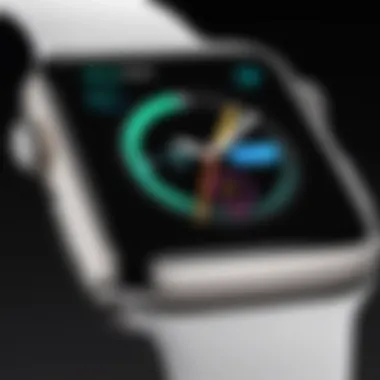
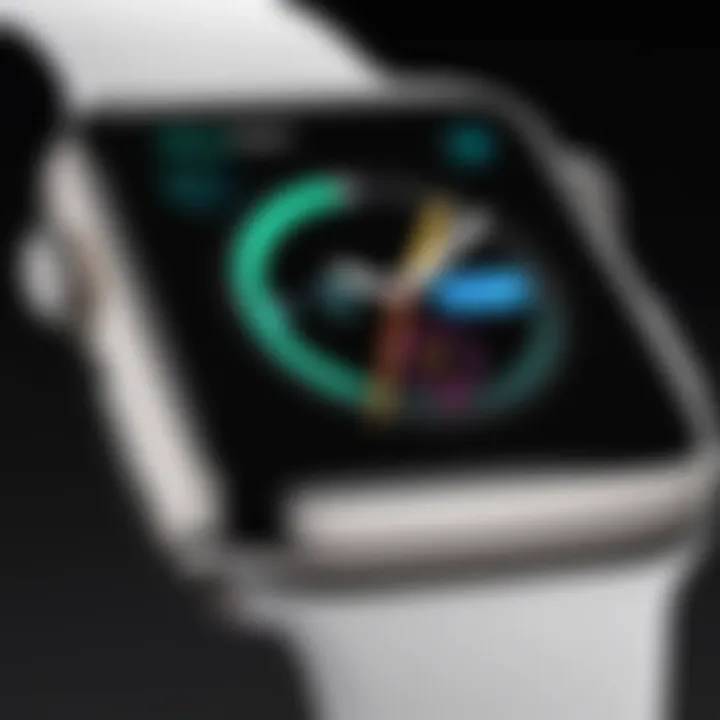
Historical Context
The historical context of the Apple Watch illuminates the broader evolution of wearable technology. Recognizing this trajectory helps explain the significance of the device in modern life. Each technological transformative step paved the way for innovations, leading to the introduction of Apple Watch. Understanding this background offers insights into how consumer expectations and industry standards evolved. The interrelation between past developments and contemporary features highlights why the Apple Watch became a game-changer in personal technology.
Pre-Apple Watch Developments
Prior to the release of the Apple Watch, several key developments defined the landscape of wearable technology. The idea of wearable devices is not new. Fitness trackers, smartglasses, and other forms began emerging long before Apple entered the market. For instance, the Fitbit, introduced in 2009, redefined personal fitness monitoring. It popularized features like step tracking and calorie counting. Moreover, smartwatches like the Pebble paved the way for more advanced capabilities, such as notifications and app integration. These products set a precedent for what consumers might want in a smartwatch, creating a demand for enhanced functionality and aesthetics. This foundation helped Apple identify gaps and opportunities within the market.
The Birth of the Apple Watch
The launch of the Apple Watch in 2015 marked a new chapter for wearable technology. Apple aimed to combine fitness tracking, communication, and style, making the watch not just a tech gadget, but also a fashion accessory.
Timeline of Key Events
The timeline surrounding the Apple Watch’s development is quite detailed. It began with speculation and rumors in 2012, culminating in announcement at the September 2014 event. The release in April 2015 saw immediate attention. Key milestones included:
- 2012: Initial design concepts emerge.
- 2014: Official announcement at the September Apple event.
- 2015: First-generation Apple Watch released.
- 2016: Introduction of the Apple Watch Series 2.
Each of these events highlights Apple's strategic approach and marketing skills. The carefully paced announcements maintained consumer interest. As a result, when the product finally launched, it received widespread media coverage.
Initial Reception and Critique
The initial reactions to the Apple Watch were mixed. Critics pointed out that while it offered appealing features, it faced questions about necessity. Some early adopters praised its design and health tracking abilities, such as heart rate sensors. However, the battery life and the need for an iPhone connection were notable drawbacks. Users appreciated its notification and communication functions, but many felt the experience was incomplete without the phone. This debate underscored the distinct challenges Apple faced in convincing a skeptical audience of the smartwatch's value proposition. As feedback came in, Apple used it to shape future iterations, proving that customer input can guide technological development.
Overall, the historical context of the Apple Watch underlines its significance in the evolution of wearable technology. It ties back to earlier innovations and the company’s strategic decisions to meet market needs. Through understanding the past, we gain insight into how the Apple Watch transformed expectations surrounding personal technology.
Technical Specifications
Technical specifications are crucial in understanding the capabilities and limitations of the Apple Watch. These specifications provide insights into hardware and software features, which directly influence user experience. They determine how well the device performs daily tasks, interacts with other devices, and supports the user in achieving their health and fitness goals.
Hardware Components
Sensors and Processing
The sensors and processing technology in the Apple Watch are fundamental to its operation. They enable the device to collect data on user activity and health metrics efficiently. Key characteristics include the integration of advanced sensors like the heart rate monitor and accelerometer. These components allow the Apple Watch to deliver real-time feedback to users about their physical activities and overall health.
One unique feature is the ability to measure heart rate variabilities, which is vital for users who want to monitor their health conditions closely. The advantage here is the capability to gather insightful data that can assist in detecting unusual heart activity or stress levels. However, sometimes, these sensors may face accuracy challenges under certain conditions, like intense workouts where motion can affect readings.
Battery Technology
Battery technology is another vital aspect of the Apple Watch's technical specifications. The longevity and efficiency of the battery impact the user's experience considerably, as a smartwatch is meant to be worn throughout the day without frequent recharges. The key characteristic of the Apple Watch's battery is its optimized performance tailored to power-saving modes during inactivity. This design choice allows users to extend the device's usability for longer periods without needing daily charging.
A unique feature is the fast charging capability, which enables the watch to provide a few hours of usage with just a short charging time. The downside is that even with advanced technology, battery life can still fluctuate based on usage patterns, which might lead to some users feeling they need to charge the device more often than desired.
Software and User Interface
Operating System Overview
The operating system powering the Apple Watch plays a pivotal role in its functionality and user interaction. It is designed specifically for wearable technology, prioritizing efficiency and ease of use. A major characteristic is its seamless integration with iOS, allowing for extensive connectivity with other Apple devices. This aspect enhances the ecosystem experience, making it easier for users to access notifications and apps.
A unique feature of the Apple Watch's operating system is its ability to run various applications directly on the device without relying on a constant connection to an iPhone. This provides an independent experience, particularly beneficial for users on the go. Nevertheless, users may find that some heavy applications can lead to reduced performance, especially if the device is running low on memory.
App Ecosystem
The app ecosystem surrounding the Apple Watch is extensive and continuously evolving. This is vital to user experience as it facilitates various functionalities ranging from fitness tracking to health monitoring. A notable characteristic is the accessibility of third-party applications that augment the watch's native capabilities. Users can personalize their experience significantly by choosing from numerous applications designed specifically for the Apple Watch.
The unique feature of this ecosystem is the compatibility with different development frameworks, allowing for creative and functional apps. For instance, applications that focus on customized workout plans or sleep tracking can be integrated easily. However, users might encounter challenges with app performance or battery consumption depending on how extensively these apps use the Watch’s hardware resources.
The technical specifications of the Apple Watch illustrate not only its advanced technology but also its adaptability to user needs, making it a leading choice in wearable devices.
By examining these specifications, it is clear how they reflect the Apple Watch's role in our increasingly technology-driven lives. As we continue to explore its design philosophy and key features, the importance of these specifications cannot be understated in defining its market presence.
Design Philosophy
The design philosophy of the Apple Watch is a crucial component in understanding its success and integral role in the wearable technology market. This philosophy combines aesthetics and functionality, showing how design directly impacts user experience. A well-thought-out design can make technology not only more accessible but also more desirable. The blend of visual appeal and practicality distinguishes the Apple Watch in a saturated market, ensuring that users are not just purchasing a gadget, but a tool that represents a lifestyle choice.
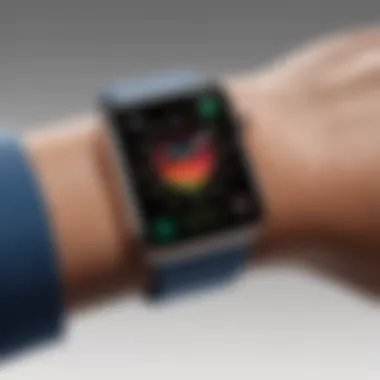
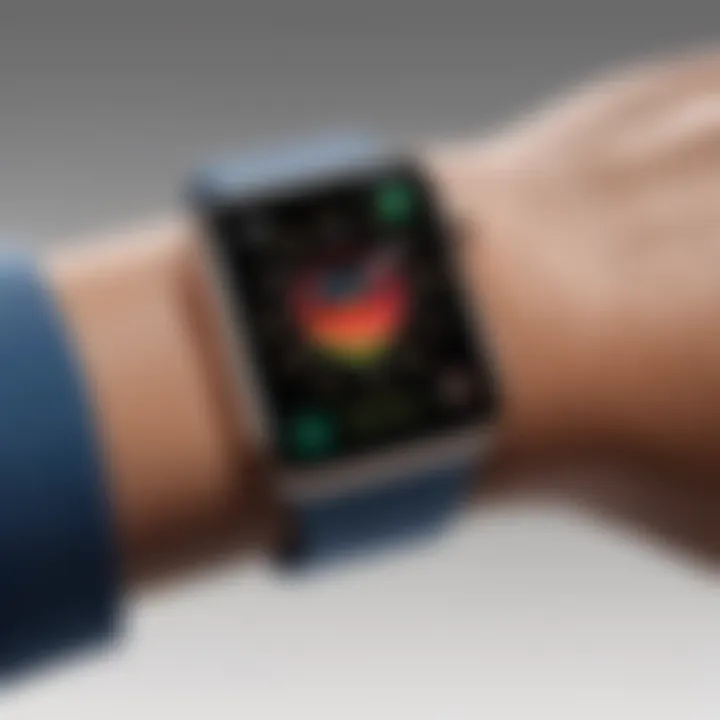
Aesthetic Elements
Aesthetic elements play a significant role in the Apple Watch's appeal. Apple has consistently focused on simplicity and elegance in its product designs. The Apple Watch features a sleek profile with customizable watch faces and bands, allowing users to express their individuality. This personal touch enhances emotional connection to the device.
The materials used in the construction of the Apple Watch also contribute to its overall aesthetic. Stainless steel, aluminum, and ceramic options provide durability while maintaining a high-end look. The screen utilizes Ion-X glass or sapphire crystal, depending on the model. This attention to detail results in a device that is visually stunning yet functional.
Moreover, the design incorporates various sizes and styles tailored for different demographics. This versatility means that the Apple Watch can appeal to a wide audience. Users can select a model that fits their personal style—whether sporty or formal—creating a device that feels uniquely theirs.
"Apple's design philosophy proves that a product can be both beautiful and functional, a balance that sets it apart in the tech landscape."
Functionality and Usability
Functionality and usability are central to the Apple Watch’s design philosophy. Apple emphasizes intuitive interfaces and user-friendly navigation. The watchOS interface is designed for ease of use, allowing users to quickly access notifications, health metrics, and apps with minimal friction. This is particularly important given the small screen size; design choices reflect a deep understanding of user behavior and preferences.
Touch gestures, like swiping and tapping, contribute to this usability. The Digital Crown allows users to scroll and zoom, feeling natural and responsive. Furthermore, voice commands via Siri enable hands-free interaction, meaning users can engage with their watch without being distracted from their tasks.
The consideration for accessibility also showcases Apple's commitment to functionality. Features such as VoiceOver and customizable text sizes ensure that users with different needs can utilize the device effectively.
Key Features of the Apple Watch
The Apple Watch stands out in the world of smartwatches, largely due to its unique and valuable features. Understanding these features helps in recognizing the watch's broad appeal and importance. The device serves not just as a timepiece but as a multifaceted tool for health tracking, communication, and daily management. The features have significantly shaped consumer expectations and behavior in wearable technology.
Health and Fitness Tracking
Health and fitness tracking are among the primary reasons users choose the Apple Watch. The design integrates advanced sensors and software to monitor various health metrics. These features empower users to take control of their wellness through actionable insights and continuous monitoring.
Heart Rate Monitoring
Heart rate monitoring is a standout characteristic of the Apple Watch. This feature allows users to observe their heart rate throughout the day, providing valuable data on their cardiovascular health. The convenience of real-time monitoring means that individuals can respond proactively to anomalies. This capability makes heart rate monitoring a beneficial choice for users focused on health.
Some unique aspects include the watch’s ability to notify users of unusually high or low heart rates. This function can act as an early warning system for potential health issues. However, reliability can vary, and it is a good practice to consult healthcare professionals for critical health decisions.
Workout Tracking
Workout tracking is another essential aspect of the Apple Watch. Users can select various types of workouts, from running to swimming, allowing tailored tracking for each activity. This feature provides insights into metrics like calories burned, distance covered, and duration. Such detailed feedback is a major advantage for fitness enthusiasts and casual users alike.
One of the unique features is the GPS tracking for outdoor activities. This allows users to map their routes and analyze performance over time. While the watch excels in offering a diverse set of metrics, some may find the need for continuous charging during long workout sessions a limitation.
Connectivity and Notifications
Connectivity and notifications elevate the Apple Watch experience. The seamless integration with iOS devices means that users can stay connected without constantly checking their smartphones. This interconnectedness is a crucial aspect of modern gadget usability and convenience.
Integration with iOS Devices
The integration with iOS devices enhances the Apple Watch's functionality. Notifications from calls, messages, and apps can be managed directly from the watch. This feature enables users to remain connected while on the go, which is very advantageous
A specific benefit is the ability for users to respond to messages quickly via voice dictation or preset responses. However, reliance on a paired iPhone could be a drawback for those who prefer greater independence from their devices.
Communication Features
Communication features provide another layer of practicality to the Apple Watch. Users can make calls, send messages, and even use apps such as FaceTime directly from their watch. This hands-free capability is especially useful when multitasking.
The unique ability to receive notifications from third-party apps adds to its appeal, keeping users updated on important alerts. While convenient, some users report that the small screen can make typing messages challenging. Yet, for quick interactions, the communication features are invaluable.
In summary, the Apple Watch’s key features establish it as a leader in the market, offering users exceptional health tracking and robust connectivity, tailored for the demands of modern life.
Impact on Consumer Technology
The Apple Watch has profoundly influenced consumer technology, reshaping how people interact with digital devices. Its entrance into the market established not only a new category of wearable technology but also set new standards for functionality, design, and user experience. Consumers have demonstrated a growing expectation for devices that seamlessly integrate into their daily lives, offering immediate access to information and enhancing personal health metrics. This influence can be traced back to the Apple Watch's innovative features combined with a strong marketing strategy.
Changing Consumer Expectations
The advent of the Apple Watch revolutionized expectations surrounding what a smartwatch could achieve. With features such as health tracking, customizable notifications, and a variety of apps, it has fueled a desire in consumers for more interconnected and intelligent devices. People now expect not only basic functionalities but also advanced features like ECG monitoring and fall detection. This shift reflects a broader trend where users are demanding enhanced personalization and more control over their health and lifestyle through technology.
- Health Monitoring: Users desire features that keep track of their physical well-being.
- User-Friendly Interface: A UI that allows for easy navigation is critical for enhancing user experience.
- Seamless Device Integration: There is a need for devices to work effortlessly together, creating a cohesive ecosystem.
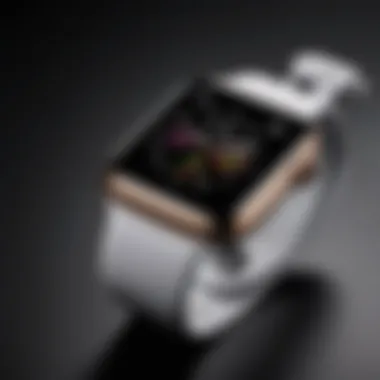
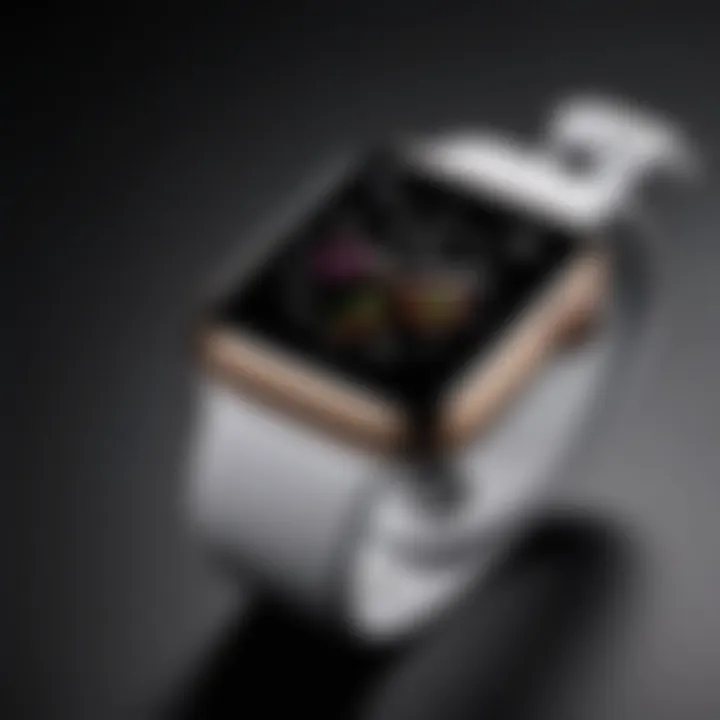
The Apple Watch, by meeting and exceeding these needs, has influenced what consumers seek from similar products. The success of the Apple Watch has set a precedent in the tech industry, prompting users to expect these capabilities from other smart devices.
Influence on Competitors
The Apple Watch did not just create a demand but also shifted how competitors approach smartwatch design and functionality. Many brands have been compelled to innovate and improve their offerings to match Apple's sophisticated features. Companies like Samsung, Fitbit, and Garmin have all introduced competing models, often incorporating health-tracking elements, customizable faces, and robust app ecosystems to remain relevant in a rapidly evolving market.
"Apple Watch has raised the bar for what consumers contemplate when looking at smartwatches, urging competitors to innovate in ways previously unconsidered."
- Samsung Galaxy Watch: Competes closely with features like sleep tracking and a rotating bezel for navigation.
- Fitbit Versa: Focuses heavily on health and fitness but lags in general smartwatch capabilities compared to Apple.
- Garmin Fenix Series: Targets outdoor enthusiasts with advanced tracking features but still adapts design cues from the Apple Watch.
Apple Watch in the Context of Health Monitoring
The Apple Watch has revolutionized how individuals engage with their health and wellbeing. This smartwatch is more than just a fashionable accessory; it serves as a powerful tool for health monitoring. As a part of this article, examining the Apple Watch's role in health monitoring highlights its features, benefits, and broader implications in preventive health and medical research.
Role in Preventive Health
The preventive health aspect of the Apple Watch is crucial. It enables users to monitor various health metrics in real time. Metrics such as heart rate, exercise duration, and even sleep quality can be tracked efficiently. This constant monitoring allows for early detection of potential health issues, promoting proactive management of personal health. By alerting users to abnormal heart rates or irregularities in their vitals, the watch encourages a lifestyle that prioritizes health.
Some essential benefits include:
- Continuous Monitoring: The Apple Watch can keep track of heart rate and activity levels throughout the day. This creates a comprehensive picture of a user’s health.
- Notifications for Abnormalities: Alerts for unusually high or low heart rates can signal users to seek medical advice before an issue escalates.
- Fitness Goals: By setting fitness goals, users can rely on the watch to help maintain levels of activity, which contributes to overall health improvement.
In addition to personal health management, the Apple Watch has the potential to impact public health. Data collected can contribute to larger studies and trends that analyze population health behaviors, informing future health initiatives.
Research and Clinical Applications
Beyond personal use, the Apple Watch is making strides in clinical applications and research. Health institutions are beginning to recognize the potential of wearable technology for clinical assessments and trials. For example, its integration into research projects allows scientists to gather data without invasive methods.
The watch can help in:
- Remote Patient Monitoring: Patients with chronic conditions can be monitored remotely. This saves time and resources for both healthcare providers and patients.
- Clinical Trials: By utilizing the watch in clinical trials, researchers can collect valuable data on patient responses to treatments in real time, thus improving the quality of research.
- Health Data Aggregation: Coupled with health apps, data from the Apple Watch can contribute to a broader database for analysis, allowing for more extensive research into health trends.
"Wearable technology like the Apple Watch not only empowers patients but also enhances the capability of healthcare professionals to provide context-specific care."
Future Directions
The future of the Apple Watch technology is an area of significant interest for both consumers and tech analysts alike. As the market for wearable technology continues to grow, the Apple Watch remains at the forefront due to its robust infrastructure and continual upgrades. Understanding the future directions of the Apple Watch helps to highlight specific elements that may enhance functionality, improve user experience, and further integrate health tracking into daily life.
Predicted Technological Advances
Several predicted technological advances are likely to shape the future of the Apple Watch. These advancements include:
- Improved Health Sensors: Future iterations may include more sophisticated health monitoring capabilities, such as blood glucose monitoring or advanced sleep tracking. Integrating these technologies would allow users to gain deeper insights into their health.
- Enhanced Battery Life: Technology developments in battery technology might lead to longer usage times. This improvement will address one of the common complaints users have: the need for frequent recharging.
- Increased Customization: Apple might offer more customizable designs, allowing users to personalize their devices to match their preferences. This includes options for band materials, faces, and features tailored to individual user needs.
- Greater Integration with Smart Home Devices: As smart homes become more prevalent, future Apple Watches could collaborate more seamlessly with home devices for tasks such as controlling lights, thermostats, or security systems.
- Augmented Reality Features: The introduction of augmented reality functionalities could create a new dimension of interaction, blending digital information with the physical world in a manner users have not previously experienced.
Overall, these predictions suggest that Apple Watch will not only continue its focus on health but will also expand its role as a central hub for various digital experiences.
Challenges Ahead for Apple Watch
Despite its successes, the Apple Watch faces several challenges that could impact its future. These challenges include:
- Market Saturation: As more competitors enter the wearable technology space, standing out becomes increasingly difficult. The Apple Watch must consistently innovate to maintain its market position.
- Privacy and Health Data Security: With an increase in health data collection, Apple must ensure that user data is protected. Failure to address privacy concerns can lead to loss of consumer trust.
- User Adoption of Health Monitoring Features: Some users may not fully embrace the health features available on the Apple Watch. Apple's challenge will be to demonstrate the practical value of these features in everyday life.
- Price Sensitivity: The premium pricing of Apple Watch might deter potential customers. Apple will have to consider strategies to appeal to a broader audience without compromising quality.
Addressing these challenges will require a strategic vision that prioritizes innovation, user needs, and market trends.
The future of the Apple Watch promises to offer exciting developments while also necessitating careful navigation of the obstacles that lie ahead. By understanding both the advancements and challenges, consumers and industry observers can grasp the potential evolution of this influential gadget.
Closure
The exploration of the Apple Watch has shed light on its remarkable journey from inception to a vital component of modern technology. Understanding the importance of the Apple Watch is critical for grasping how wearable devices shape consumer habits and influence personal health. This article has highlighted various elements, including the device's technological advancements, design philosophy, and significant impact on health monitoring.
Summary of Key Points
The Apple Watch emerged as a pioneering gadget that has defined new standards in wearable tech. The following key points encapsulate the findings of this article:
- Evolution from basic fitness trackers to sophisticated health monitoring tools
- Integration of extensive sensors providing real-time data
- Impact on preventive health care and consumer expectations
- Continuous updates enhancing functionality and user experience
The Apple Watch not only serves as a tech accessory but also acts as a health companion. This versatility supports a wide range of users, from those interested in fitness to individuals managing chronic conditions. The device's ability to harmonize with iOS devices further elevates its role in the ecosystem of technology today.
"The Apple Watch is a clear illustration of how technology can bridge health and connectivity, offering users a comprehensive tool for personal well-being."
Final Thoughts on the Apple Watch's Position in Tech
In considering the Apple Watch's trajectory in the technological landscape, it becomes evident that it occupies a unique niche. As consumer expectations evolve, so too does the Apple Watch's functionality and relevance. Its success is not merely measured by sales figures, but by the ways it transforms user behavior and health monitoring.
The continual enhancements in software, user interface, and sensor technology position the Apple Watch as a leader in wearable technology. Its ongoing evolution suggests that it will remain a vital player in the realm of consumer technology. Thus, the Apple Watch has redefined the norms of what users expect from wearable devices, fostering a culture where health and connectivity are seamlessly integrated.



